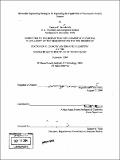Molecular engineering strategies for expanding the capabilities of fluorescent zinc (II) sensors
Author(s)
Woodroofe, Carolyn C., 1977-
DownloadFull printable version (7.835Mb)
Other Contributors
Massachusetts Institute of Technology. Dept. of Chemistry.
Advisor
Stephen J. Lippard.
Terms of use
Metadata
Show full item recordAbstract
(cont.) affords the two fluorophores, such that excitation of the coumarin at 445 nm and measurement of the emission at 488 nm affords information of the amount of sensor present, while excitation of the fluorescein at 505 nm and measurement of the emission at 535 nm indicates the amount of sensor in the zinc(II)-bound form. This system has been characterized and applied to the study of exogenous zinc(II) fluxes in HeLa cells. Chapter 4: Unimolecular Two-Fluorophore Ratiometric Zn²⁺ Sensing Systems. Dichlorofluorescein compounds covalently bound to zinc(II)-insensitive reporter fluorophores via a rigid cyclohexyl linker have been prepared and characterized. Based on favorable photophysical properties, a Zinpyr-1 species covalently bound to coumarin 343 has been prepared and shown to afford a ratiometric response to excess zinc(II). Chapter 5: ZPI Synthons for Functionalization of Biological Targets. Installation of a functional group prior to Mannich reaction is impractical in many cases. This chapter describes the preparation of reactive ZP1 synthons for direct functionalization of biological targets containing an amine or azide, and reports applications to the synthesis of ZPI conjugates. Appendix 1: Synthetic Approaches to Other Isomerically Pure Functionalizable Fluorophores. Crystallization approaches have been applied to separate fluorescein 5- and 6-sulfonic acid, and subsequent generation of the sulfonyl chlorides is discussed. A dibromofluoran approach to isomerically pure rhodamine carboxylates is based on a similar separation. Basic hydrolysis of the previously described 2',7'-dichlorofluorescein ... Chapter 1: The Development and Use of Fluorescent Sensors in the Imaging of Physiological Zinc(II): A Review This chapter presents an overview of fluorescent techniques used to image chelatable zinc(II) in vivo. Many intensity-based sensors take advantage of photoinduced electron transfer quenching pathways. Peptide- and protein-based sensors offer excellent selectivity but are poorly suited to intracellular applications. Recently, ratiometric sensors in which the zinc(II) binding event interrupts or alters conjugation within the fluorophore have been described. Chapter 2: Carboxylate-Functionalized Zinpyr-1 Sensors: Synthesis, Characterization, and In Vivo Staining Patterns. A class of Zinpyr-1 sensors containing a carboxylic acid or ester at the 5- or 6-position of the fluorescein has been prepared. These sensors offer decreased background fluorescence and enhanced fluorescence response compared to the parent Zinpyr-1. The acid-functionalized sensors bear a negative charge at physiological pH, rendering them cell-impermeable. The esterified sensors are cell-permeable, but are hydrolyzed in vivo by intracellular esterases, affording a clear delineation of zinc(II)-containing damaged neurons in mechanically-injured or seizure-induced rats, rather than the punctate staining pattern obtained with Zinpyr-1. Chapter 3: Esterase-Dependent Two-Fluorophore Ratiometric Sensing of Zinc(II). This chapter describes a new approach to ratiometric sensing in which a zinc(II)-sensitive fluorescein fluorophore based on Zinpyr-1 is functionalized with a zinc(lI)-insensitive coumarin fluorophore via a flexible ester linker. The flexible linker enables intramolecular quenching of the two fluorophores. Esterase hydrolysis of the linker
Description
Thesis (Ph. D.)--Massachusetts Institute of Technology, Dept. of Chemistry, 2004. Vita. Includes bibliographical references.
Date issued
2004Department
Massachusetts Institute of Technology. Department of ChemistryPublisher
Massachusetts Institute of Technology
Keywords
Chemistry.